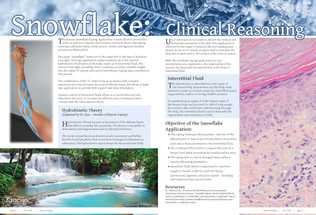May 13th 2020
Snowflake: Clinical Reasoning. Objective of the Snowflake Application.
The Kinesio Snowflake Taping Application is most effective around the joint, as well as to improve the function of muscle fascia. This taping technique addresses many levels: muscle, tendon and ligament (mainly around a problem joint.)
The name “snowflake” refers not to the shape but to the type of stimulus, very light. This tape application makes maximal use of the natural hydrokinetic fluid layers in the body, made up of interstitial fluid. The action of this light, snowflake level of stimulus provides valuable insight into the repair of injured cells and to how Kinesio Taping may contribute to this process.
 The combination of the “I” center strip as an anchor with rounded extensions not only increases the area of affected tissue, but allows a single tape application to provide both support and deep stimulation.
The combination of the “I” center strip as an anchor with rounded extensions not only increases the area of affected tissue, but allows a single tape application to provide both support and deep stimulation.
Optimal control of interstitial fluids allows us to work with very soft stimulus to the joint, to increase the affected area of treatment and to connect with the subcutaneous fascia.
Use it when you do not want to disturb the vertical and horizontal movement of the skin. This application is effective for the repair of fascia in the surrounding joint tissues. It can act to release pressure and to stimulate the deep fascia layers and to the surface of the joint or muscle.
With the snowflake taping application you can revolutionize your approach to the relationship of the muscle, the fascia and the natural flow in the body of interstitial fluid.
Hydrokinetic Theory (Explained by Dr. Kase – Inventor of Kinesio Taping) Hydrokinetic Theory focuses on the nature of the delicate fascia that affects everyday life repeatedly. The fascia is susceptible to deformation and degeneration and to external influences. The moist normal fascia moderates muscle movement and bathes the blood and lymphatic flow to promote drainage of inflammatory substances. The hydrokinetic aspect keeps the fascia soft and fluffy.
Objective of the Snowflake Application:
● This taping technique allows greater exercise of the affected joint or muscle by soft stimulation around the joint and is ideal adjustment to the interstitial fluid.
● The combined effect will be to support the joint at a deeper level while increasing the treated surface area.
● The taping acts to restore damaged tissue without merely addressing lymphatics.
● Interstitial fluid, which is important for nutrition supply to tissues, is able to reach the fascia, aponeurosis, ligament, and joint capsule - including subcutaneous tissue around joints.
Interstitial Fluid
The Interstitium is described as a new organ of the human body. Researchers say this body-wide network is made up of interconnected, fluid-filled spaces supported by a lattice of strong, flexible proteins.
If considered as an organ, it is the largest organ of the human body and accounts for 20% of body weight (in contrast, skin constitutes 16%.) Running through the body, the interstitial fluid is said to help with the regeneration and restoration of cells.
Resources P.C. Benias et al., “Structure and distribution of an unrecognized interstitium in human tissues,” Scientific Reports, doi:10.1038/s41598-018-23062-6, 2018.Rettner. R. (2018) Meet you interstitium, a newfound “organ”. Retrieved from
https://www.scientificamerican.com/article/meet-your-interstitium-a-newfound-organ/




